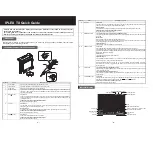
TN_US-BA-e-2020
13
4.3.2 Calibration at known sound velocity
Note: For this procedure the sound velocity of the material to be measured must be
known. A table of the most common materials can be found in Appendix A of this
manual.
1. Press the key to activate the calibration mode. The MM (or IN) symbol should
start flashing.
2. Press this button repeatedly so that the M/S (or IN/ µS) symbol also flashes.
3. Use the and
keys to
adjust the sound velocity value up or down until it
corresponds to the sound velocity of the material to be measured. It is also
possible to use the key to switch between the preset, generally used velocities
of sound.
4. To exit the calibration mode, press the key. From now on measurements can
be made.
In order to obtain the most accurate measurement result possible, it is generally
recommended to calibrate the measuring instrument with a material sample of known
material thickness.
The material composition itself (and thus the speed of sound) often varies from one
manufacturer to another. Calibration with a material sample of known thickness
ensures that the instrument is adjusted as accurately as possible to the material to be
measured.
4.3.3 Two-point calibration
This procedure assumes that the user has two known material thickness points of the
test material and that these are representative for the measuring range.
1. The zero setting is made
2. Coupling agent is applied to the material sample.
3. The US measuring probe is placed on it (at the first or second calibration point)
and the correct position of the US measuring head on the material sample is
checked. The display should now show a measured value and the coupling
symbol should appear.
4. As soon as a stable measured value is reached, the sound generator is lifted
off. If the reading differs from that when the transducer was coupled, step 3 must
be repeated.
5. The key is pressed and the M/S (or IN/ µS) should start flashing.
6. The and keys
can now be used to correct the required material thickness
on the display until it matches that of the material pattern.







































